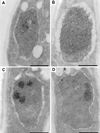The role of the Schizosaccharomyces pombe gar2 protein in nucleolar structure and function depends on the concerted action of its highly charged N terminus and its RNA-binding domains
- PMID: 9693363
- PMCID: PMC25453
- DOI: 10.1091/mbc.9.8.2011
The role of the Schizosaccharomyces pombe gar2 protein in nucleolar structure and function depends on the concerted action of its highly charged N terminus and its RNA-binding domains
Abstract
Nonribosomal nucleolar protein gar2 is required for 18S rRNA and 40S ribosomal subunit production in Schizosaccharomyces pombe. We have investigated the consequences of the absence of each structural domain of gar2 on cell growth, 18S rRNA production, and nucleolar structure. Deletion of gar2 RNA-binding domains (RBDs) causes stronger inhibition of growth and 18S rRNA accumulation than the absence of the whole protein, suggesting that other factors may be titrated by its remaining N-terminal basic/acidic serine-rich domain. These drastic functional defects correlate with striking nucleolar hypertrophy. Point mutations in the conserved RNP1 motifs of gar2 RBDs supposed to inhibit RNA-protein interactions are sufficient to induce severe nucleolar modifications but only in the presence of the N-terminal domain of the protein. Gar2 and its mutants also distribute differently in glycerol gradients: gar2 lacking its RBDs is found either free or assembled into significantly larger complexes than the wild-type protein. We propose that gar2 helps the assembly on rRNA of factors necessary for 40S subunit synthesis by providing a physical link between them. These factors may be recruited by the N-terminal domain of gar2 and may not be released if interaction of gar2 with rRNA is impaired.
Figures






Similar articles
-
gar2 is a nucleolar protein from Schizosaccharomyces pombe required for 18S rRNA and 40S ribosomal subunit accumulation.Nucleic Acids Res. 1995 Jun 11;23(11):1912-8. doi: 10.1093/nar/23.11.1912. Nucleic Acids Res. 1995. PMID: 7596817 Free PMC article.
-
Ultrastructural changes in the Schizosaccharomyces pombe nucleolus following the disruption of the gar2+ gene, which encodes a nucleolar protein structurally related to nucleolin.Chromosoma. 1997 Jun;105(7-8):542-52. doi: 10.1007/BF02510491. Chromosoma. 1997. PMID: 9211982
-
Mitosis-specific phosphorylation of gar2, a fission yeast nucleolar protein structurally related to nucleolin.Chromosoma. 1997 Jun;105(7-8):532-41. doi: 10.1007/BF02510490. Chromosoma. 1997. PMID: 9211981
-
The yeast nucleolar protein Nop4p contains four RNA recognition motifs necessary for ribosome biogenesis.J Biol Chem. 1997 Oct 3;272(40):25345-52. doi: 10.1074/jbc.272.40.25345. J Biol Chem. 1997. PMID: 9312154
-
Saccharomyces cerevisiae nucleolar protein Nop7p is necessary for biogenesis of 60S ribosomal subunits.RNA. 2002 Feb;8(2):150-65. doi: 10.1017/s1355838202010026. RNA. 2002. PMID: 11911362 Free PMC article.
Cited by
-
Rrp8p is a yeast nucleolar protein functionally linked to Gar1p and involved in pre-rRNA cleavage at site A2.RNA. 2000 Jun;6(6):826-43. doi: 10.1017/s1355838200992288. RNA. 2000. PMID: 10864042 Free PMC article.
-
Multiple protein kinases influence the redistribution of fission yeast Clp1/Cdc14 phosphatase upon genotoxic stress.Mol Biol Cell. 2012 Oct;23(20):4118-28. doi: 10.1091/mbc.E12-06-0475. Epub 2012 Aug 23. Mol Biol Cell. 2012. PMID: 22918952 Free PMC article.
-
A bona fide La protein is required for embryogenesis in Arabidopsis thaliana.Nucleic Acids Res. 2007;35(10):3306-21. doi: 10.1093/nar/gkm200. Epub 2007 Apr 25. Nucleic Acids Res. 2007. PMID: 17459889 Free PMC article.
-
Nucleolin (NCL) inhibits the growth of peste des petits ruminants virus.J Gen Virol. 2020 Jan;101(1):33-43. doi: 10.1099/jgv.0.001358. J Gen Virol. 2020. PMID: 31794379 Free PMC article.
-
Box C/D small nucleolar RNA trafficking involves small nucleolar RNP proteins, nucleolar factors and a novel nuclear domain.EMBO J. 2001 Oct 1;20(19):5480-90. doi: 10.1093/emboj/20.19.5480. EMBO J. 2001. PMID: 11574480 Free PMC article.
References
-
- Alfa CE, Fantes P, Hyams J, McLeod M, Warbrick E. Experiments with Fission Yeast: A Laboratory Course Manual. Cold Spring Harbor NY: Cold Spring Harbor Laboratory; 1993.
-
- Amberg DC, Goldstein AL, Cole CN. Isolation and characterization of RAT1: an essential gene of Saccharomyces cerevisiae required for the efficient nucleocytoplasmic trafficking of mRNA. Genes Dev. 1992;6:1173–1189. - PubMed
-
- Basi G, Schmid E, Maundrell K. TATA box mutations in the Schizosaccharomyces pombe nmt1 promoter affect transcription efficiency but not the transcription start point or thiamin repressibility. Gene. 1993;123:131–136. - PubMed
Publication types
MeSH terms
Substances
LinkOut - more resources
Full Text Sources
Molecular Biology Databases

